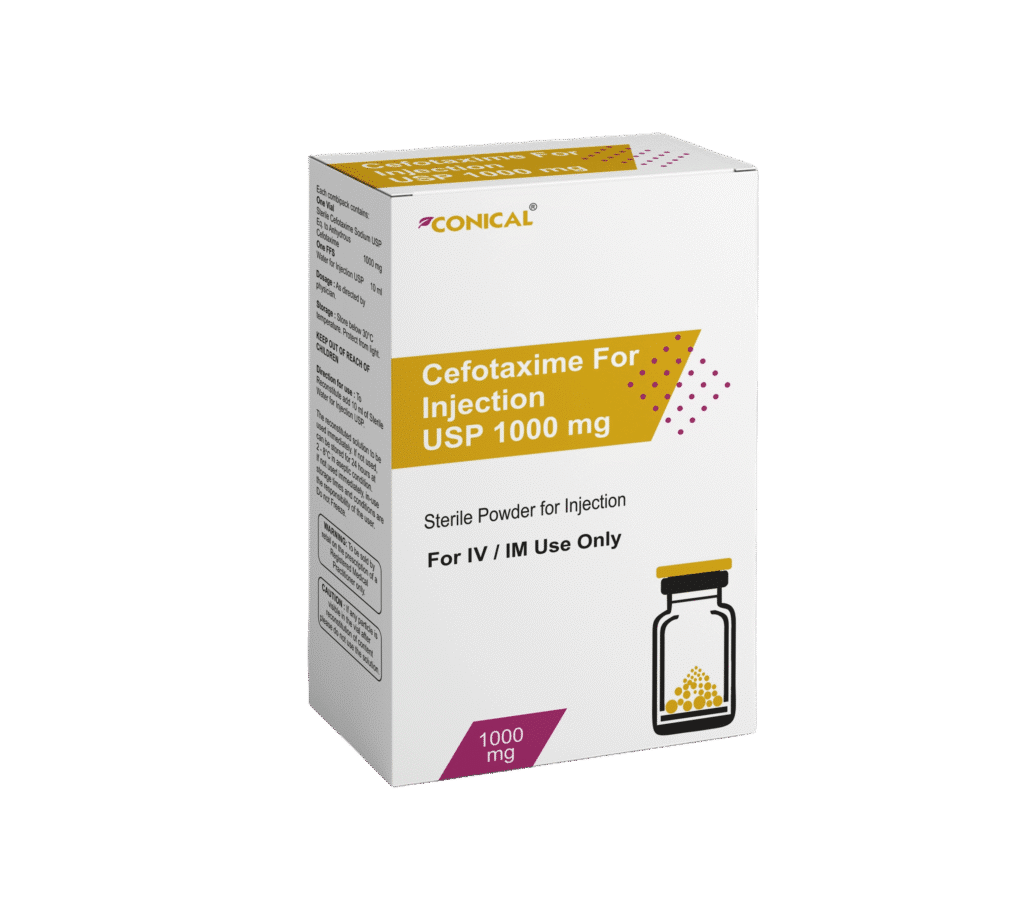







Cefotaxime is a strong antibiotic used to fight serious bacterial infections. It works by stopping bacteria from building their cell walls, which leads to their destruction.
What are the uses of Cefotaxime for Injection USP 1000 mg?
Precautions When Using Cefotaxime For Injection 1000 mg
Allergies and Cross-Reactions
Special Caution Groups
Infections and Gut Health
Blood and Lab Monitoring
Injection Safety
Sodium Content
Lidocaine-Related Warnings
If cefotaxime is mixed with lidocaine (used to reduce injection pain), it should not be used.
How Cefotaxime For Injection 1000 mg Is Given
Dosage for Adults & Teens (Over 12 Years)
| Condition | Typical Dose |
|---|---|
| Mild to moderate infection | 1 g every 12 hrs = 2 g/day |
| Moderate mixed infection | 1–2 g every 12 hrs = 2–4 g/day |
| Severe or unknown-source infection | 2–3 g every 6–8 hrs (max 12 g/day) |
| Uncomplicated Gonorrhoea | Single 0.5–1 g injection (IM or IV) |
| Urinary Tract Infection (UTI) | 1 g every 12 hrs |
| Bacterial Meningitis | 6–12 g/day in divided doses |
| Intra-abdominal Infections | Use in combination with other antibiotics |
Dosage for Infants & Children (Up to 12 Years)
| Weight | Standard Dose |
|---|---|
| <50 kg | 50–150 mg/kg/day, split into 2–4 doses |
| Severe infections | Up to 200 mg/kg/day |
| >50 kg | Use adult dosage, but max 12 g/day |
Dosage for Newborns & Premature Infants
Older Adults
Side Effects Of Taking Cefotaxime For Injection 1000 mg
Infections
Blood Disorders
Nervous System
Heart
Digestive System
Liver Function
Skin and Allergic Reactions
Other Reactions
Kidneys
Injection Site Reactions
Store below 30°C temperature. Protect from light.
Keep the medicine out of reach of children.
10 ml clear glass vial with bromobutyl rubber stopper, sealed with a flip-off aluminum seal.
Cefotaxime for Injection USP 1000 mg in a glass vial is supplied with a 10 ml plastic ampoule of diluent Sterilized Water for Injections USP in a unit carton with a pack insert.
Contact us directly to receive full information on the product, the formulation, the science behind it, stability data, and more. Our Business Development Manager is a click away.
Questions are useful tools, they open lines of communication; give us information; improve interactions, facilitate analysis, and many more.
A pharma CMO is a special kind of an organization, offering contract manufacturing services to pharmaceutical companies for various kinds of drug formulations.
Reduce overall costs and time to market :
Contract manufacturers already have the needed infrastructure and technical staff, so working with a CMO or CDMO can decrease the cost of manufacturing your pharmaceutical products.
Scalability and flexible production capacity :
You can produce what you need when you need it without worrying about excess capacity. Additionally, CMOs understand the importance of quality and compliance, so you don't have to sacrifice safety for scalability.
Save on upgrading and maintaining equipment :
If you have your manufacturing facility, you’ll have to pay to upgrade your equipment as technology advances—which can get expensive. A CMO/CDMO’s only function is to make and distribute products, so part of their core business responsibility is to update their equipment whenever needed and perform maintenance.
Ease supply chain issues :
During the pandemic, there were several instances of supply chain issues, including medicine shortages. CMOs are generally better equipped than startups to handle a supply chain crisis.
Bandwidth to focus on core competencies
When your company resources aren’t directly allocated to manufacturing and distribution, you have more time to focus on other tasks, like marketing your new drug, researching, or working on drug discovery.
We have 7+ manufacturing sites with a minimum of WHO GMP certification and other country-specific approvals like NAFDAC approved, PPK Kenya Approved, TFDA Tanzania Approved, EU-GMP Approved.
We have below manufacturing capacity:
For Tablet, Capsule, and soft gel: up to 1 million units per shift
For Syrup: up to 0.05 Million per shift
For Ampoule and Vial: up to 0.1 million units per shift
For Ointment and Cream: up to 0.1 million units per shift
For Suppository: 0.1 Million units per shift
